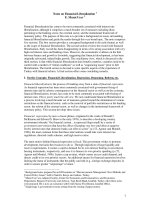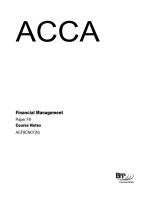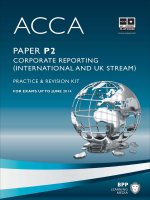ACCA SBR course notes
Bạn đang xem bản rút gọn của tài liệu. Xem và tải ngay bản đầy đủ của tài liệu tại đây (13.86 MB, 0 trang )
SBR Course notes
1
aCOWtancy.com
Syllabus A: Fundamental Ethical And Professional Principles
3
Syllabus A1. Professional Behaviour & Compliance With Accounting Standards
3
Syllabus A2. Ethical requirements of corporate reporting
7
Syllabus B: THE FINANCIAL REPORTING FRAMEWORK
12
Syllabus B1. The Applications Of An Accounting Framework
12
Syllabus C: REPORTING THE FINANCIAL PERFORMANCE OF ENTITIES
33
Syllabus C1. Performance reporting
33
Syllabus C2. Non-current Assets
51
Syllabus C3. Financial Instruments
114
Syllabus C4. Leases
159
Syllabus C5. Employee Benefits
182
Syllabus C6. Income taxes
194
Syllabus C7. Provisions, contingencies and events after the reporting date
206
Syllabus C8. Share based payment
215
Syllabus C9. Fair Value Measurement
238
Syllabus C10. Reporting requirements of small and medium-sized entities (SMEs)
242
Syllabus C11. Other Reporting Issues
252
Syllabus D: FINANCIAL STATEMENTS OF GROUPS OF ENTITIES
263
Syllabus D1. Group accounting including statements of cash flows
263
Syllabus D2. Associates And Joint Arrangements
333
Syllabus D3: Changes in group structures
343
Syllabus D4: Foreign transactions and entities
348
Syllabus E: Interpret Financial Statements For Different Stakeholders
359
Syllabus E1: Analysis and interpretation of financial information and measurement of performance
359
Syllabus F: THE IMPACT OF CHANGES AND POTENTIAL CHANGES IN ACCOUNTING
REGULATION
Syllabus F1. Discussion of solutions to current issues in financial reporting
2
393
393
aCOWtancy.com
Syllabus A: FUNDAMENTAL ETHICAL AND
PROFESSIONAL PRINCIPLES
Syllabus A1. Professional Behaviour & Compliance With
Accounting Standards
Syllabus A1a) Appraise and discuss the ethical and professional issues in advising on
corporate reporting.
Giving Advice
When giving advice be aware of:
1) Your own professional competence and that company directors must keep up to
date with IFRS developments
The issues that may threaten this are:
• Insufficient time
• Incomplete, restricted or inadequate information
• Insufficient experience, training or education
• Inadequate resources
2) Your own objectivity
The issues that may threaten this are:
• Financial interests (profit-related bonuses /share options)
• Inducements to encourage unethical behaviour
3
aCOWtancy.com
In fact ACCA’s Code of Ethics and Conduct identifies that accountants must not be
associated with reports, returns, communications where they believe that the
information:
• Contains a materially misleading statement
• Contains statements or information furnished recklessly
• Has been prepared with bias, or
• Omits or obscures information required to be included where such omission or obscurity
would be misleading
4
aCOWtancy.com
Syllabus A1b) Assess the relevance and importance of ethical and professional issues in
complying with accounting standards.
Ethical and professional issues
Accounting professionals are expected to be:
1. highly competent
2. reliable
3. objective
4. high degree of professional integrity.
A professional’s good reputation is one of their most important assets.
Accountancy as a profession has accepted its overriding need to act in the best interest
of the public.
This can create an ethical/professional dilemma.
As accountants also have professional duties to their employer and clients.
Where these duties are in contrast to the public interest, then the ethical conduct of the
accountant should be in favour of the public interest.
This can create problems particularly on an audit, whereby you provide a service for the
client, yet may have to make public information which is detrimental to the company but in
the public interest.
There is a very fine line between acceptable accounting practice and management’s
deliberate misrepresentation in the financial statements.
5
aCOWtancy.com
The financial statements must meet the following criteria:
• Technical compliance:
Generally accepted accounting principles (GAAP) used.
• Economic substance:
The economic substance of the event that has occurred must be represented
(over and above GAAP)
• Full disclosure and transparency:
Sufficient disclosures made
Management often seeks loopholes in financial reporting standards that allow them to
adjust the financial statements as far as is practicable to achieve their desired aim.
These adjustments amount to unethical practices when they fall outside the bounds of
acceptable accounting practice.
In most cases conformance to acceptable accounting practices is a matter of personal
integrity.
Reasons for such behaviour often include
1. market expectations
2. personal realisation of a bonus
3. maintenance of position within a market sector
6
aCOWtancy.com
Syllabus A2. Ethical requirements of corporate reporting
Syllabus A2a) Appraise the potential ethical implications of professional and managerial
decisions in the preparation of corporate reports.
ACCA has a Framework for Ethical Decision Making
1) Understand the Real Issue
2) Any Ethical threats?
These would be:
Self-Interest
Self-Review
Advocacy
Familiarity
Intimidation
3) Are the Ethical threats significant?
Think about materiality, seniority of people involved and the amount of judgement needed
4) Can safeguards reduce these threats to an acceptable level?
5) Can you look yourself in the mirror afterwards?
Accountants need to act professionally and in the current conditions have even more of a
duty to present fair, accurate and faithfully represented information.
It can be argued that accountants should have the presentation of truth, in a fair and
accurate manner, as a goal.
7
aCOWtancy.com
Syllabus A2b) Assess the consequences of not upholding ethical principles in the
preparation of corporate reports.
Consequences Of Not Upholding Ethical Principles
One of the more obvious consequences is professional disciplinary
proceedings against unethical members
The results can be serious…
• Fines / Prison
• No longer being able to be a Director
• Expelled from your professional body
Social Responsibility
Looking after society and the environment costs .... no question... but in today's world,
thankfully, it also brings in sales
Companies are now often called 'corporate citizens'. With that comes social responsibility.
Not taking CSR seriously will damage your chances of investment and risk losing sales
8
aCOWtancy.com
Syllabus A2c) Identify related parties and assess the implications of related party
relationships in the preparation of corporate reports.
IAS 24 Related Parties
A party is said to be related to an entity if any of the following three situations
occur:
The 3 situations are:
1. Controls / is controlled by entity
2. is under common control with entity
3. has significant influence over the entity
Types of related party
These therefore include:
1. Subsidiaries
2. Associate
3. Joint venture
4. Key management
5. Close family member of above (like my beautiful daughter pictured in her new
school uniform aaahhh)
6. A post-employment benefit plan for the benefit of employees
9
aCOWtancy.com
Not necessarily related parties
Two entities with a director in common
Two joint venturers
Providers of finance
A big customer, supplier etc
Stakeholders need to know that all transactions are at arm´s length and if not then be
fully aware.
Similarly they need to be aware of the volume of business with a related party, which
though may be at arm´s length, should the related party connection break then the
volume of business disappear also.
Disclosures
• General
The name of the entity’s parent and, if different, the ultimate controlling party
The nature of the related party relationship
Information about the transactions and outstanding balances necessary for an
understanding of the relationship on the financial statements
• As a minimum, this includes:
Amount of outstanding balances
Bad and doubtful debt information
10
aCOWtancy.com
• Key management personnel compensation should be broken down by:
• short-term employee benefits
• post-employment benefits
• other long-term benefits
• termination benefits
• share-based payment
Group and Individual accounts
1. Individual accounts
Disclose related party transactions / outstanding balances of parent, venturer or
investor.
2. Group accounts
The intra-group transactions and balances would have been eliminated.
11
aCOWtancy.com
Syllabus B: THE FINANCIAL REPORTING
FRAMEWORK
Syllabus B1. The Applications Of An Accounting
Framework
Syllabus B1a) Discuss the importance of a conceptual framework in underpinning the
production of accounting standards.
Framework - Basics and Arguments
The IASB framework is not a standard nor does it override any standards
Definition
It sets out the concepts which underlie the accounts. It means that basic principles do not
have to re-debated for every new standard.
It is..
‘a constitution, a coherent system of interrelated objectives and fundamentals which
can lead to consistent standards and which prescribe the nature, function and limits
of financial accounting and financial statements’
What’s its purpose?
The IASB’s Framework for the Preparation and Presentation of Financial Statements
describes the basic concepts by which financial statements are prepared:
• Serves as a guide in developing accounting standards.
12
aCOWtancy.com
• Serves as a guide to resolving accounting issues that are not addressed directly in a
standard.
(In fact IAS 8 requires management to consider the definitions, recognition criteria, and
measurement concepts for assets, liabilities, income, and expenses in the Framework.)
What does it ‘look’ like?
It includes the following:
1. The objective of financial statements
2. Underlying assumptions
3. Qualitative characteristics of good information
4. Elements of FS
5. Recognition of Elements
6. Measurement of Elements
7. Concepts of Capital
More on these in other sections
Arguments for a conceptual framework
• It may seem a very theoretical document but it has highly practical aims.
• Without a framework then standards would be developed without consistency and also
the same basic principles would be continually examined. Perhaps even sometimes with
differing conclusions.
• The IASB therefore becomes the architect of financial reporting with a framework as
solid foundations upon which everything else relies.
• Also without such a framework then a rules based system tends to come in instead. The
rules get added to as situations arise and finally become cumbersome and unadaptable.
13
aCOWtancy.com
• It also prevents political lobbyists from changing pressurising changes in standards as
the principles have already been agreed upon.
So a conceptual framework basically provides a framework for:
1. what should be brought into the accounts
2. when it should be brought into the accounts and
3. at how much it should be measured
Arguments against a conceptual framework
• Financial Statements are prepared for many different users - can one set of principles be
agreed by all?
• Perhaps different users need different information and hence different measurement
bases and principles
• Even with framework principles - standards go through a huge analysis process, for
example the revenue recognition exposure draft has now been re-exposed!
GAAP & the framework
In some ways the framework tries to codify the current GAAP into new standards - or
at least current thinking
14
aCOWtancy.com
Syllabus B1b) Discuss the objectives of financial reporting including disclosure of
information that can be used to help assess management’s stewardship of the entity’s
resources and the limitations of financial reporting.
Chapter 1: The Objective of Financial Reporting
The objective is to provide financial information that is useful to present and potential
equity investors, lenders and other creditors in making decisions.
The degree to which that financial information is useful will depend on its qualitative
characteristics.
A few observations about the objective:
• Wide Scope
Its scope is wider than financial statements. It is the objective of financial reporting in
general.
• Users
Financial reporting is aimed primarily at capital providers. That does not mean that
others will not find financial reports useful. It is just that, in deciding on the principles for
recognition, measurement, presentation, and disclosure, the information needs of capital
providers are paramount.
• Decision usefulness & stewardship
Decision usefulness to capital providers is the overriding purpose of financial reporting,
as well as assessing the stewardship of resources already committed to the entity.
The ability of management to discharge their stewardship responsibilities effectively has
an effect on the entity’s ability to generate net cash inflows in the future, implying that
potential investors are also assessing management performance as they make their
investment decision.
15
aCOWtancy.com
• Capital providers - main users
The Framework identifies equity investors, lenders and other creditors as ‘capital
providers’.
Governments, their agencies, regulatory bodies, and members of the public are identified
as groups that may find the information in general purpose financial reports useful.
However, these groups have not been identified as primary users.
Limitations of FS
The Boards note that users of financial reports should be aware of the limitations of the
information included in such reports – specifically, estimates and the use of judgement.
Additionally, financial reports are but one source of information needed by those who make
investment decisions. Information about general economic conditions, political events and
industry outlooks should also be considered.
Financial reporting should also include management’s explanations, since management
knows more about the entity than external users.
What to Report and Where
• Economic Resources and Claims in the SOFP
• Changes in ER & C (caused by financial performance) in SOCI
• Changes in ER & C (NOT caused by financial performance) in SOCIE
• Changes in cashflows in SOCF
16
aCOWtancy.com
Syllabus B1c) Discuss the nature of the qualitative characteristics of useful financial
information.
Chapter 3: Qualitative Characteristics of Useful
Financial Information
Main Principle
Financial information is useful when it is relevant and represents faithfully what it purports
to represent.
The usefulness of financial information is enhanced if it is comparable, verifiable, timely
and understandable.
Fundamental characteristics:
1. Relevance
Relevant information makes a difference in the decisions made by users.
Therefore it must have a predictive value, confirmatory value, or both. The predictive
value and confirmatory value of financial information are interrelated.
Materiality is an entity-specific aspect of relevance. It is based on the nature and/or
size of the item relative to the financial report.
2. Faithful representation
General purpose financial reports represent economic phenomena in words and
numbers.
To be useful, financial information must not only be relevant, it must also represent
faithfully the phenomena it purports to represent.
This maximises the underlying characteristics of completeness, neutrality and freedom
from error.
17
aCOWtancy.com
Enhancing characteristics:
1. Comparability (including consistency)
2. Timeliness
3. Reliable information
4. Verifiability
Helps to assure users that information represents faithfully the economic phenomena
that it purports to represent.
It implies that knowledgeable observers could reach a general consensus (although
not necessarily absolute agreement) that the information does represent faithfully the
economic phenomena.
5. Understandability
Enables users with a reasonable knowledge to comprehend the information.
Understandability is enhanced when the information is:
• Classified
• Characterised
• Presented clearly and concisely
However, relevant information should not be excluded solely because it may be too
complex.
Two constraints that limit the information provided in useful financial reports:
1. Materiality
Information is material if its omission or misstatement could influence the decisions
that users make on the basis of an entity’s financial information.
Materiality is not a matter to be considered by standard-setters but by preparers and
their auditors.
2. Cost-benefit
The benefits of providing financial reporting information should justify the costs of
providing that information.
18
aCOWtancy.com
Potential Problems
Decision usefulness seen as more important than the giving information about how well
the company is being looked after (Stewardship).
Although it may be said that stewardship is taken into account when talking about decision
usefulness - perhaps there should be a more specific mention of it.
Faithful representation has replaced reliability.
This is even more vague and could lead to problems regarding treatment of some items
where substance over form exists
Should it encompass not for profits also?
Why the split between fundamental and enhancing characteristics?
19
aCOWtancy.com
Faithful Representation
Accounts must represent faithfully the phenomena it purports to represent
Faithful representations means
1. Substance over form
Faithful representation means capturing the real substance of the matter.
2. Represents the economic phenomena
Faithful means an agreement between the accounting treatment and the economic
phenomena they represent.
The accounts are verifiable and neutral.
3. Completeness, Neutrality & Verifiability
Examples
Sell and buy back = Loan
An entity may sell some inventory to a finance house and later buy it back at a price based
on the original selling price plus a pre-determined percentage. Such a transaction is really
a secured loan plus interest. To show it as a sale would not be a faithful representation of
the transaction.
Convertible Loans
Another example is that an entity may issue convertible loan notes.
Management may argue that, as they expect the loan note to be converted into equity, the
loan should be treated as equity.
They would try to argue this as their gearing ratio would then improve. However, it is
recorded as a loan as primarily this is what it is.
20
aCOWtancy.com
As noted previously, simply following rules in accounting standards can provide for
treatment which is essentially form over substance.
Whereas, users of accounts want the substance over form.
The concept behind faithful representation should enable creators of financial statements
to faithfully represent everything through measures and descriptions above and beyond
that in the accounting standard if necessary.
Limitations to Faithful Representation
1. Inherent uncertainties
2. Estimates
3. Assumptions
21
aCOWtancy.com
Syllabus B1d) Explain the roles of prudence and substance over form in financial
reporting.
Prudence
In 2010, the IASB decided to remove the word ‘prudence’ from its conceptual
framework.
The previous version of the conceptual framework defined prudence as ‘the inclusion of a
degree of caution in the exercise of the judgements needed in making the estimates
required under conditions of uncertainty, such that assets or income are not overstated
and liabilities or expenses are not understated’.
In other words, err on the side of caution. But not too much. The framework stated
‘prudence does not allow, for example, the creation of hidden reserves or excessive
provisions’.
So why remove it from the framework?
Because it's inconsistent with the principle of neutrality.
Faithful representation of transactions and balances needs neutrality, or free from bias.
And prudence is, ultimately, bias!
So is Prudence dead?!
No!:
• The standard on accounting policies (IAS 8) states that management should use its
judgement, that results in prudent
• The standard on accounting policies (IAS 8) states that management should use its
judgement, that results in prudent
• The standard on provisions (IAS 37) requires potential liabilities to be only ‘probable’ but
potential assets have to be ‘reasonably certain’.
• The standard on Fair Values (IFRS 13) says that level 3 assets and liabilities might need
a risk adjustment when there is significant measurement uncertainty
22
aCOWtancy.com
Bringing Prudence back?
IASB has proposed to reinstate prudence into its framework
Calling it the exercise of caution when making judgments under conditions of uncertainty.
Maybe it will be re-introduced but highlighting that we must keep neutral too wherever
possible
23
aCOWtancy.com
Syllabus B1e) Discuss the high level of measurement uncertainty that can make financial
information less relevant.
Measurement Uncertainty And Relevance
Too many measurement techniques?
What makes a good measurement method?
• Its cost should be justified by the benefits of reporting that information to users
• It should be the minimum necessary to provide relevant information
• It should mean infrequent changes (any necessary changes clearly explained)
• The same method for initial and subsequent measurement (for comparability and
consistency purposes)
The existing Conceptual Framework worryingly provides very little guidance on
measurement
Why not use one measurement basis for everything?
It may not provide the most relevant information to users - (although many call for the use
of current values to provide the most relevant information)
What methods do IFRSs therefore use?
Fair value, historical cost, present value and net realisable value.
Why?
Different information from different measurement bases may be relevant in different
circumstances.
So what's wrong with this?
Different measurement bases may mean the totals in financial statements have little
meaning.
24
aCOWtancy.com
Using 'Current Value'
Profit orientated businesses turn has market input values (inventory for example) into
market output values (sales of finished products)
Therefore current market values should play a key role in measurement.
This would be the most relevant measure of assets and liabilities for financial reporting
purposes. (in these circumstances)
Mixed Measurement Approach
The IASB favour a mixed measurement approach - the most relevant method is selected.
Investors feel that this approach is consistent with how they analyse financial statements
Maybe its problems of mixed measurement are outweighed by the greater relevance
achieved.
• IFRS 9 requires the use of cost in some cases and fair value in other cases
• IFRS 15 essentially applies cost allocation
Measurement Uncertainty
Measurement uncertainty of an item should be considered when assessing whether a
particular measurement basis provides relevant information.
However, most measurement is uncertain and requires estimation.
For example, recoverable value for impairment, depreciation estimates and fair value
measures at level 2 and 3 under IFRS 13.
The IASB thinks that the level of measurement uncertainty that makes information lack
relevance depends on the circumstances and can only be decided when developing
particular standards.
Cash-flow-based measurement can be used to customise measurement bases, which can
result in more relevant information but it may also be more difficult for users to understand.
25
aCOWtancy.com









